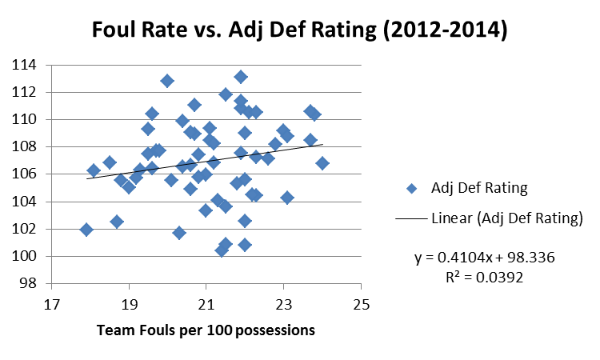The Correlation Between Team Stats and Offensive and Defensive Efficiency, Part 5: Fouls

Today we are continuing our six-part series on the relationship between a variety of team statistics and offensive and defensive efficiency. So far we’ve looked at steals, blocks, turnovers, and rebounds. Today’s topic? Team fouls.
Let’s jump right into it.
How Fouls Affect Team Offenses
The data over the last two years shows that there's no determinable correlation between team fouls and offensive efficiency. This isn’t all that surprising – the majority of team fouls are defensive, so team foul rates will likely make a very small difference on the offensive end. As you can see, the plot points are all over the place.

The 10-year data shows that there has been a negative correlation in the last decade. For every team foul, that team can expect their offensive efficiency to decrease by 0.19. However, our coefficient of determination is still low enough where we can pretty much assume no correlation.

It's interesting that it would still be slightly negative, and it might be explained by the nature of undisciplined teams. A young, lottery-bound team might foul a lot as they learn to play defense, and it’s not that crazy to think that same team might be also offensively inefficient. There can be a correlation between the two without it being a direct correlation. In other words, teams in the last 10 years that foul a lot also have slightly less efficient offenses, but their offenses are probably not inefficient because of the team’s foul rate.
There is a common phrase for this: correlation does not imply causation. And this is important with this entire series. We can look at data all day long, but it does take interpretation to determine whether two things have an effect on each other (causation), or if they’re coincidentally correlated.
How Fouls Affect Team Defenses
Over the last two years, a team foul has resulted in giving up 0.41 points per 100 possessions more on the defensive end. However, we have had teams on either end of the spectrum post good team defenses recently.

For example, the Oklahoma City Thunder fouled a lot last year and ended up with a top-five defense in the league, adjusted for opponent. Meanwhile, the San Antonio Spurs are almost always on the bottom of the list of fouling teams, yet they always have a top defensive squad as well. What gives?

When our data is expanded 10 years, the trend goes to the point above – there may not really be any correlation between fouling and non-fouling teams and good and bad defenses.
The Minnesota Timberwolves have been a topic of this recently, and especially last season. The Timberwolves kept their foul rate so low, and analysts were skeptical of why they were doing this. It’s almost counterintuitive to how we think about defense. A good defense requires being physical and dominating the inside. If you aren’t fouling, you’re being soft, some analysts would say.
And while that might be generally true – it’s hard to argue with the Bulls, Pacers, and Grizzlies being physically imposing in the paint and also being really good defensively – it doesn’t seem like fouling or “playing tough†is mutually exclusive with having an efficient defense. After all, the Miami Heat won two championships in the last four years despite not having a rim protector or true inside presence.
After watching the Charlotte Hornets craft a top-six defense in the league while giving most of their frontcourt minutes to Al Jefferson and Josh McRoberts, I think there are multiple ways to develop a good defense. It doesn’t always have to include a shot blocker or frontcourt physicality. And it seems like the data in the last decade backs that up.
















